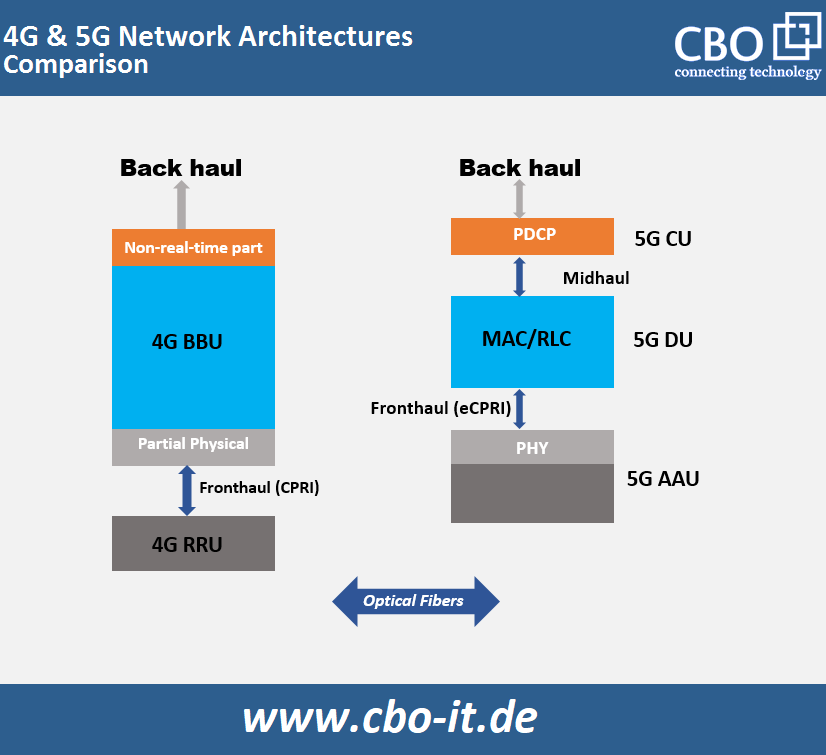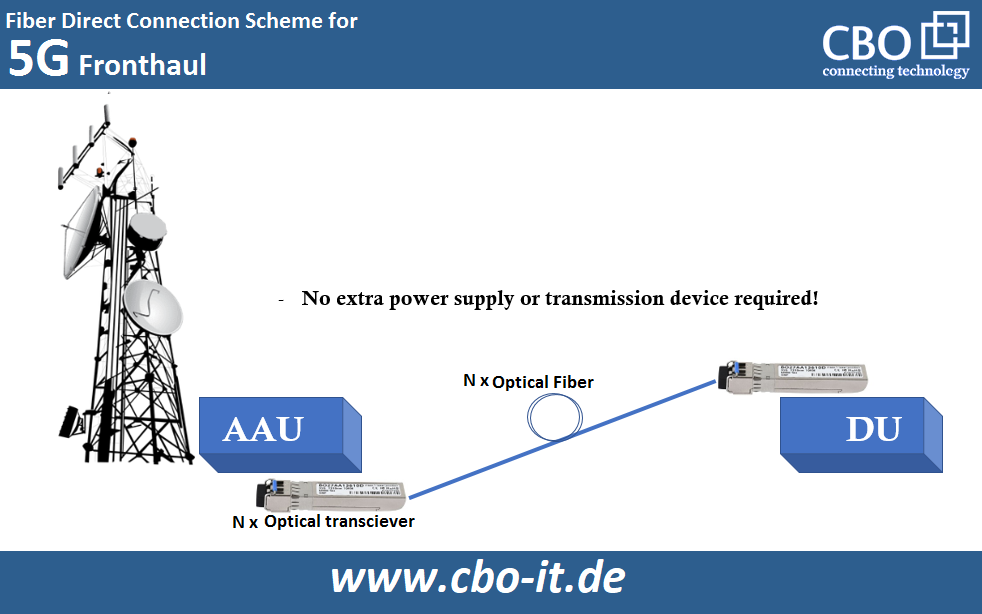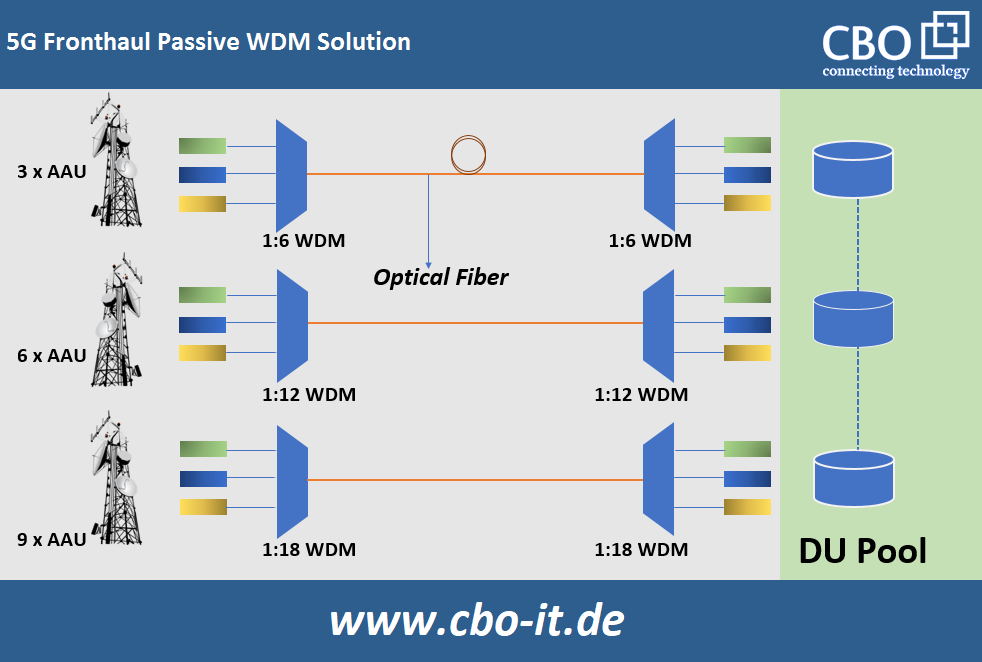Optical networking devices play a vital role in optical transmission networks. They perform various functions at the network's physical layer, such as; wavelength multiplexing, optical power distribution, and photoelectric conversion. It is a reality that optical devices played a significant role in the success of 3G and 4G networks. However, when it comes to 5G networking, considerable challenges exist concerning the fronthaul and middle haul connectivity. We will talk about those challenges and the possible solutions in this post, but let us clarify what it means when we say fronthaul and middle haul in the context of 5G networking.
Architectural Differences between 4G and 5G
.png)
- The functions of 4G BBUs are distributed between two new components; CU and DU. CU handle the non-real-time services and protocols, whereas we have DUs for the remaining BBU functions.
- The antenna is reconstructed into AAU (active antenna unit). The AAU performs the physical layer processing functions of the original RRU, original BBU, and passive 4G antenna.
- DUs (distributed units) handle the real-time services and physical layer protocols. In 4G networks, we have BBUs to handle these protocols and services.
- CPRI communication protocol is used for fronthaul data transmission in 4G, and it is replaced by eCPRI in 5G.
What are 5G Fronthaul, Mid-haul (or middle-haul), and backhaul?

In 5G networks, "Fronthaul" refers to the communication links connecting the tower mount radio equipment and the distributed units. The 5G fronthaul handles the real-time and real-time services. Generally, fronthaul data is transmitted over optical fiber cables. Middle-haul links are the ones that connect distributed units to the central units, and these links operate with non-real-time services and protocols. The backhaul connects 5G subnetworks to the core networks.
Optical Components Considerations for 5G Fronthaul and Mid-haul links
In 5G networks, the wireless base stations are usually deployed on the roof of the buildings or the communication towers. So, the optical devices used in the middle-haul and fronthaul must be capable of withstanding harsh outdoor conditions. The operating temperature range of these optical components must comply with the temperature range requirements for the industrial-grade equipment i,e -40 to 85℃. For indoor deployments, optical components must adhere to the temperature requirements for commercial grade equipment i.e. 0 to 70℃.
Generally, the transmission distance required for 5G fronthaul links remains below 10km, of which 5 to 10 kilometers accounts for 20%, and less than 5 kilometers accounts for 80%. However, it is something that changes from application to application. We must factor in the increasing attenuation across each fronthaul link for safe planning due to the degrading of the optical fiber cable laid in atmospheric conditions.
The specified link distance range is 10 to 40 kilometers for middle-haul links. Thus, the equipment used in the middle-haul links must comply with the requirements specified for the industrial-grade equipment by various bodies.
Proposed 5G Fronthaul and Middle-Haul Solutions
We all know optical transceivers use photoelectric conversion to convert electrical signals into optical signals and use optical fiber cables for data transmission. So, the maximum cost relates to the optical fiber resources in any optical network. That is why networks are designed to focus on resource optimization, and a lot of money can be saved by using fewer optical fiber cables. In the following part of this post, we will talk about three viable networking solutions for building fronthaul and mid-haul optical fiber links!
First Option: 25G BiDi SFP28 Transceivers

In cases where there is no shortage of resources, we can use 25G BiDi SFP28 modules to achieve direct connectivity between pole mount equipment and distributed units. In most cases, one base station houses three cells. This scheme will require three optical fiber cables for the fronthaul linking of one base station. This arrangement is widely known as One Fiber One Cel, and it can work for links ranging from 10 to 20 kilometers.
Second Option: WDM Scheme
Another viable solution for achieving fronthaul 5G links is the multiplexing of various services. In this technique, each service wavelength handled by a base station is multiplexed onto a pair of fibers or a single fiber to save resources. WDM scheme is also known as 1-Fiber 1-Site scheme. However, this option can be typical in many cases because it will incorporate various color optical modules. Thus, it will be challenging to design, deploy and maintain. Here comes the role of tunable optical transceivers. These transceivers can make the deployment of the WDM scheme a bit easier.
So, many operators have made it possible to use 25G tunable SFP28 modules and passive optical components such as 5G CCWDM modules and 5G OMUX to establish robust 5G fronthaul links. The active WDM scheme is better as it will keep the system backward compatible with the existing 3G and 4G services. Moreover, the active WDM scheme offers better optimization and management capabilities. However, it will cost more to build active WDM links than passive WDM links.
Third Option: Passive WDM Scheme
 0
0
DWDM and CWDM are two types of available passive wavelength-division. In passive WDM fronthaul configuration, multiple base stations are connected to one DU through point-to-multipoint P2MP networking. This option is similar to the second option as both of them use WDM for data transmission between AAUs and DUs. However, setting up a passive WDM scheme is more cost-effective than active WDM. The 40-Channel DWDM Mux/Demux is a popular 5G fronthaul option as it can link up to six base stations to DUs, provided that each station has three cells.
The availability of suitable AWGs is essential for this option. Currently, the commercial-grade AWGs commonly available on the market are not capable enough of withstanding harsh environments. However, some vendors are claiming to have developed athermal AWGs. We can also use PLC splitters as a substitute to AWGs as the industrial version of these splitters can withstand outdoor environments.
Conclusion
The inception of 5G is a revolutionary step in the history of networking. However, the ongoing pandemic, semiconductor crises, and other geopolitical issues, in addition to inadequate technical theory, are a few challenges both consumers and hardware manufacturers are facing.
The best viable option for fronthaul networking is the direct fiber connection scheme. Active and passive WDM schemes are also feasible for this cause, but suitable hardware is still a big question. In this post, we talked about three possible solutions for constructing fronthaul and middle-haul 5G links. We believe by the end of 2022, things will get more transparent, and we will see other reliable 5G connectivity options.
 English
English
 Deutsch
Deutsch
 Espaniol
Espaniol










